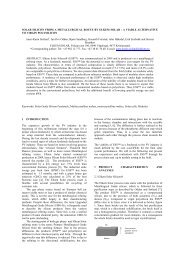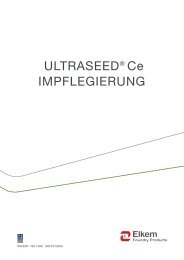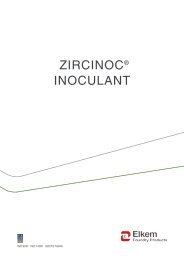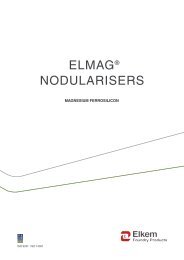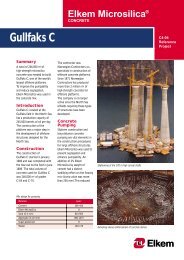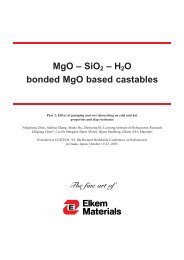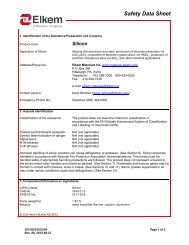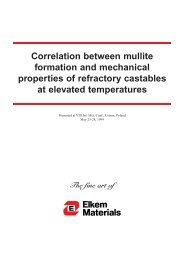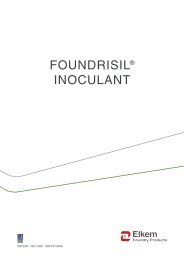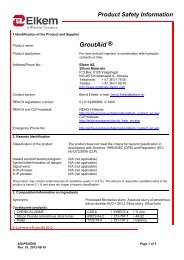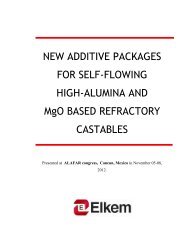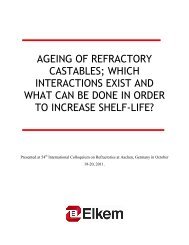Microsilica in Refractory Castables- Surface Properties and ... - Elkem
Microsilica in Refractory Castables- Surface Properties and ... - Elkem
Microsilica in Refractory Castables- Surface Properties and ... - Elkem
You also want an ePaper? Increase the reach of your titles
YUMPU automatically turns print PDFs into web optimized ePapers that Google loves.
densely packed castable systems where cement is<br />
present. The calcium <strong>and</strong> alum<strong>in</strong>ate cations from<br />
the cement dissolve <strong>and</strong> attack the otherwise fluid<br />
bond phase. To prevent this coagulation, the<br />
calcium ions have to be prevented from absorb<strong>in</strong>g<br />
on the microsilica. This may either be done by<br />
hav<strong>in</strong>g a pH below 5, but as this may affect sett<strong>in</strong>g;<br />
addition of a proper amount of a polyelectrolyte or<br />
a surface active agent is a common stratagem. The<br />
surface active agent, normally termed deflocculant<br />
(<strong>in</strong> Portl<strong>and</strong> cement based systems termed<br />
plasticiser or superplasticiser), is believed to absorb<br />
to the surfaces thus prevent<strong>in</strong>g the absorption of<br />
calcium but it also creates an equal, normally<br />
negative charge of the particles of the bond system.<br />
As the particles then will repel each other, cast<strong>in</strong>g<br />
can take place at reduced water additions.<br />
Deflocculants commonly used are polyphosphates,<br />
e.g. sodium hexametaphosphate (Calgon) at<br />
approximately 0.2 wt% addition level, <strong>and</strong><br />
polyacrylates (Darvan 811D, 0.05 wt %).<br />
The deflocculat<strong>in</strong>g mechanisms <strong>in</strong>volved falls<br />
normally <strong>in</strong>to two ma<strong>in</strong> groups or comb<strong>in</strong>ation<br />
thereof:<br />
1) Steric stabilisation, the deflocculant attaches to<br />
the f<strong>in</strong>es <strong>and</strong> the size of it prevents<br />
agglomeration of particles<br />
2) Electrostatic stabilisation, the deflocculant<br />
creates an equal electrical charge on the surface<br />
of the f<strong>in</strong>es. Electrostatic repulsion prevents<br />
particles from agglomeration.<br />
3) Comb<strong>in</strong>ation of 1) <strong>and</strong> 2):<br />
The recent years a new group of deflocculants have<br />
emerged on the market conta<strong>in</strong><strong>in</strong>g both steric<br />
groups <strong>and</strong> electrical charges which gives a<br />
“double” deflocculat<strong>in</strong>g effect (typically Castament<br />
FS20 from BASF). Below, <strong>in</strong> Figure 3, the structure<br />
of such a deflocculant is sketched. And <strong>in</strong> Figure 4<br />
the deflocculat<strong>in</strong>g action is visualised.<br />
Figure 3. Structure of a comb<strong>in</strong>ed steric <strong>and</strong> electrostatic deflocculant. A typically polycarboxylate “backbone”<br />
with polyether sidecha<strong>in</strong>s.<br />
Figure 4.Visualisation of the deflocculat<strong>in</strong>g mechanism of a compound like the one presented <strong>in</strong> Figure 3.



